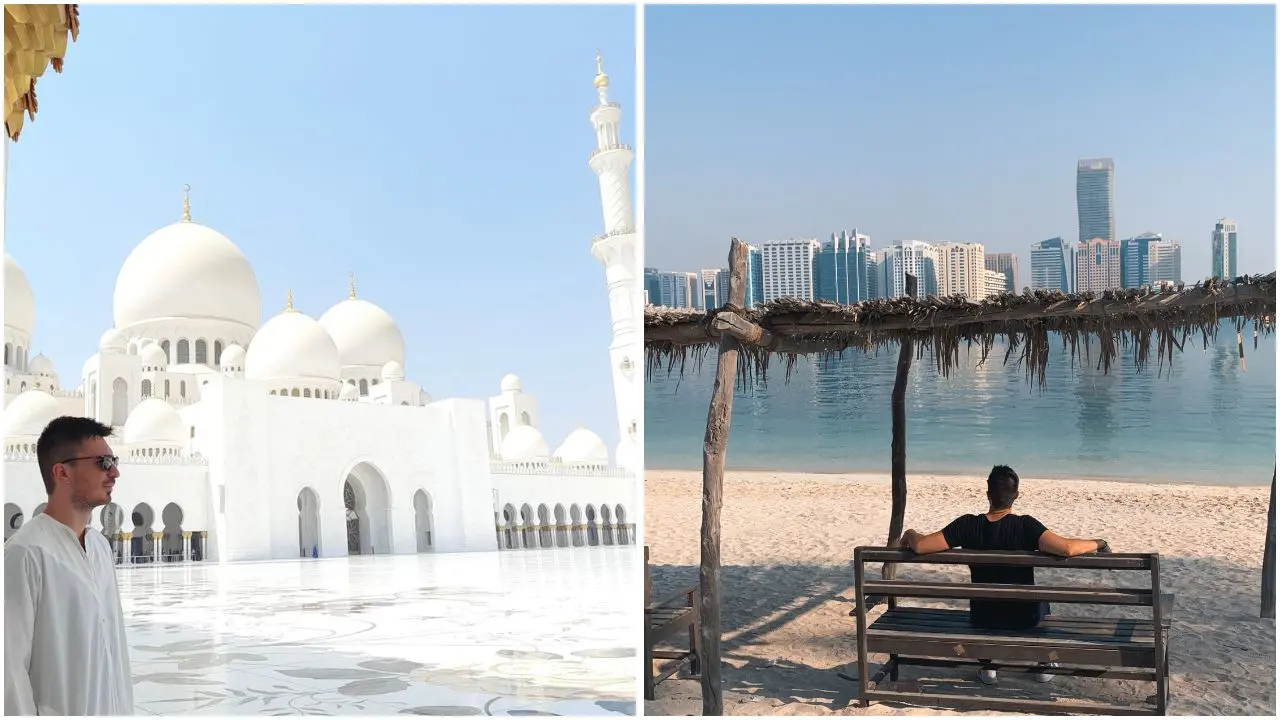Un viaggio tra grattacieli, deserti e storie invisibili: la vertigine di un’epoca che corre veloce. Qui, più che altrove, il confine tra miraggio e realtà è sempre stato solo una questione di prospettiva
Tutti gli articoli di Attualità
PHOTO
C’è un momento, arrivando a Dubai, in cui ti rendi conto che nulla di quello che hai visto in foto rende giustizia alla vertigine di quella skyline. È come sbarcare su un set cinematografico dove tutto, i grattacieli, le strade, le palme perfette, sembra disposto con un rigore da scenografia. Poi cammini tra la gente, assapori l’umidità calda del Golfo, e capisci che questa città, così artificiale eppure così viva, è un esperimento sociale unico al mondo.
Dubai, che nel 2003 contava poco più di un milione di abitanti, oggi ne ospita oltre 3,5 milioni, con grattacieli che sfiorano i 900 metri (Burj Khalifa) e un’economia trainata da turismo, finanza e aviazione (Emirates è diventata una delle compagnie aeree più potenti al mondo).
Essa ti accoglie con il suo caos ordinato: taxi Lexus, donne in abiti firmati che passeggiano nel Dubai Mall davanti all’acquario da record, operai pakistani che bevono chai in attesa del turno di notte. La prima reazione è meraviglia: com’è possibile che qui, dove vent’anni fa c’era solo sabbia, oggi si alzino questi grattacieli, torreggianti e irraggiungibili come un faro del capitalismo globale?
Poi arrivi ad Abu Dhabi, e il ritmo cambia. La capitale è più austera, più elegante. I viali larghi, le moschee bianche, il silenzio dorato del deserto che ancora resiste tra un grattacielo e l’altro.
Eppure, anche qui, la sfida è la stessa: costruire un’utopia moderna. Il Louvre Abu Dhabi, con la sua cupola che filtra la luce come un souk stellare, ne è la prova: un luogo che non dovrebbe esistere, e invece c’è, e ti lascia senza fiato.
Viaggiando tra questi Emirati, però, capisci che ogni scintillio ha un’ombra. A Dubai, dietro alla perfezione degli hotel a 7 stelle, ci sono le vite invisibili dei lavoratori migranti, quelli che costruiscono quegli stessi palazzi per poi vivere in periferie lontane. Ad Abu Dhabi, la grandeur culturale convive con un controllo sociale che si percepisce nell’aria, nelle regole non scritte, negli sguardi cauti di chi non vuole problemi.
Nonostante tutto, è opportuno puntualizzare che negli ultimi anni, Dubai e Abu Dhabi hanno compiuto passi significativi per migliorare le condizioni dei lavoratori a basso salario, soprattutto nel settore edile e domestico, con l'abolizione del sistema "kafala", controverso sistema che legava i lavoratori migranti a un singolo datore di lavoro. Infatti, ora è possibile cambiare lavoro senza il consenso del precedente sponsor. Inoltre, da non sottovalutare, l'introduzione del salario minimo.
Eppure, per quanto la strada sia ancora lunga e le contraddizioni restano evidenti a chiunque visiti gli Emirati con occhio critico, non si può fare a meno di innamorarsene. Forse per il coraggio di aver sfidato ogni limite. Forse perché, in fondo, queste città sono il riflesso di un’epoca: la nostra, fatta di eccessi, velocità e voglia di stupire.
Cosa resta al viaggiatore? Io me lo sono chiesto spesso, tornando a casa. Dubai e Abu Dhabi non sono posti da “amare o odiare”. Sono specchi distorti ma sinceri del mondo in cui viviamo: ambiziosi, spietati, generosi, contraddittori. Quando riparti, ti porti dentro il ricordo delle notti sul Corniche, delle cene tra i suk dove l’incenso si mescola al profumo dello zaatar, della sensazione unica di camminare in un futuro che altrove è solo fantasia.
E probabilmente, il loro segreto è proprio questo: far credere, almeno per un attimo, che anche l’impossibile possa diventare ordinario. Perché qui, più che altrove, il confine tra miraggio e realtà è sempre stato solo una questione di prospettiva.
------------------------
Dubai and Abu Dhabi: A Traveler’s Dream and Reality Among the Desert’s Mirages
There’s a moment, when arriving in Dubai, when you realize that nothing you’ve seen in photos can truly capture the dizzying impact of its skyline. It feels like stepping onto a movie set, where everything, the skyscrapers, the streets, the perfectly aligned palm trees, seems arranged with the precision of stage design. Then you walk among the people, feel the warm humidity of the Gulf, and understand that this city, so artificial and yet so alive, is a social experiment unlike any other in the world.
Dubai, which in 2003 had just over one million inhabitants, is now home to more than 3.5 million, with skyscrapers reaching nearly 900 meters (like the Burj Khalifa) and an economy powered by tourism, finance, and aviation (Emirates has become one of the world’s most powerful airlines).
It welcomes you with its orderly chaos: Lexus taxis, women in designer clothes strolling through the Dubai Mall in front of the record-breaking aquarium, Pakistani workers sipping chai while waiting for their night shift. Your first reaction is awe, how is it possible that here, where there was only sand twenty years ago, now rise these towering, unreachable monuments to global capitalism?
Then you reach Abu Dhabi, and the pace changes. The capital is more austere, more elegant. Wide boulevards, white mosques, the golden silence of the desert still lingering between skyscrapers. Yet even here, the challenge is the same: to build a modern utopia. The Louvre Abu Dhabi, with its dome filtering light like a starlit souk, is proof of that: a place that shouldn’t exist, and yet does and leaves you breathless.
Traveling through these Emirates, however, you realize that every sparkle casts a shadow. In Dubai, behind the perfection of 7-star hotels, are the invisible lives of migrant workers, those who build the same towers but live on the outskirts. In Abu Dhabi, cultural grandeur coexists with a form of social control you can feel in the air, in the unspoken rules, in the cautious glances of those who don’t want trouble.
Nonetheless, it’s important to acknowledge that in recent years, Dubai and Abu Dhabi have made significant progress in improving conditions for low-wage workers, particularly in construction and domestic work, including the abolition of the kafala system, a controversial sponsorship model that bound migrant workers to a single employer. Today, it’s possible to change jobs without the previous sponsor’s consent. Also worth noting is the introduction of a minimum wage.
Still, while the road ahead is long and the contradictions remain evident to anyone who visits the Emirates with a critical eye, it’s impossible not to fall in love with them. Perhaps it’s the courage to defy every limit. Perhaps because, deep down, these cities reflect our era: one of excess, speed, and a desire to amaze.
What remains for the traveler? I’ve asked myself that many times after returning home. Dubai and Abu Dhabi are not places to “love or hate.” They are distorted but honest mirrors of the world we live in ambitious, ruthless, generous, contradictory. When you leave, you carry with you the memory of nights on the Corniche, of dinners among the souks where incense mingles with the scent of za’atar, and the unique feeling of walking in a future that, elsewhere, is only fantasy.
And perhaps that’s their true secret: making you believe, even for a moment, that the impossible can become ordinary. Because here, more than anywhere else, the line between mirage and reality has always been just a matter of perspective.

